
- Subject:
- Applied Science
- Biology
- Life Science
- Material Type:
- Module
- Date Added:
- 07/10/2017

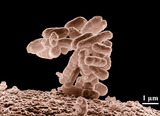
By the end of this section, you will be able to:Identify the shared characteristics of the natural sciencesSummarize the steps of the scientific methodCompare inductive reasoning with deductive reasoningDescribe the goals of basic science and applied science

By the end of this section, you will be able to:Identify the shared characteristics of the natural sciencesSummarize the steps of the scientific methodCompare inductive reasoning with deductive reasoningDescribe the goals of basic science and applied science
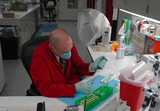
By the end of this section, you will be able to:Identify and describe the properties of lifeDescribe the levels of organization among living thingsRecognize and interpret a phylogenetic treeList examples of different sub disciplines in biology

By the end of this section, you will be able to:Identify and describe the properties of lifeDescribe the levels of organization among living thingsRecognize and interpret a phylogenetic treeList examples of different sub disciplines in biology
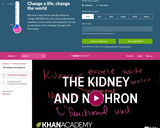
This 19-minute video lesson provides an overview of how the nephrons in the kidney filter blood and reabsorb water and other molecules. [Biology playlist: Lesson 59 of 71].
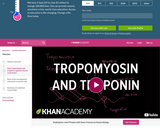
This 9-minute video lesson looks at tropomyosin and troponin and their role in regulating muscle contraction. How calcium ion concentration dictates whether a muscle is contracting or not. [Biology playlist: Lesson 48 of 71].
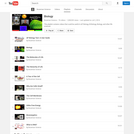
Series of videos that can be used in a Biology class created by Paul Anderson- Bozeman Science
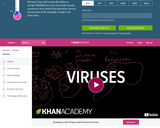
This 23-minute video provides an introduction to viruses. [Biology playlist: Lesson 19 of 71].

Short Description:
In this survey text, directed at those not majoring in biology, we dispel the assumption that a little learning is a dangerous thing. We hope that by skimming the surface of a very deep subject, biology, we may inspire you to drink more deeply and make more informed choices relating to your health, the environment, politics, and the greatest subject that all of us are entwined in, life itself. This text also includes interactive H5P activities that you can use to evaluate your understanding as you go.
Long Description:
In this survey text, directed at those not majoring in biology, we dispel the assumption that a little learning is a dangerous thing. We hope that by skimming the surface of a very deep subject, biology, we may inspire you to drink more deeply and make more informed choices relating to your health, the environment, politics, and the greatest subject that all of us are entwined in, life itself. This text also includes interactive H5P activities that you can use to evaluate your understanding as you go.
In the adapted textbook, Concepts of Biology, you will find the following units: Unit 1: Principles of Cellular Life Unit 2: Principles of Inheritance Unit 3: Principles of Evolution Unit 4: Principles of Ecology
Word Count: 189879
(Note: This resource's metadata has been created automatically by reformatting and/or combining the information that the author initially provided as part of a bulk import process.)

Short Description:
In this survey text, directed at those not majoring in biology, we dispel the assumption that a little learning is a dangerous thing. We hope that by skimming the surface of a very deep subject, biology, we may inspire you to drink more deeply and make more informed choices relating to your health, the environment, politics, and the greatest subject that all of us are entwined in, life itself. This text also includes interactive H5P activities that you can use to evaluate your understanding as you go.
Long Description:
In this survey text, directed at those not majoring in biology, we dispel the assumption that a little learning is a dangerous thing. We hope that by skimming the surface of a very deep subject, biology, we may inspire you to drink more deeply and make more informed choices relating to your health, the environment, politics, and the greatest subject that all of us are entwined in, life itself. This text also includes interactive H5P activities that you can use to evaluate your understanding as you go.
In the adapted textbook, Concepts of Biology, you will find the following units: Unit 1: Principles of Cellular Life Unit 2: Principles of Inheritance Unit 3: Principles of Evolution Unit 4: Principles of Ecology
Word Count: 189359
(Note: This resource's metadata has been created automatically by reformatting and/or combining the information that the author initially provided as part of a bulk import process.)
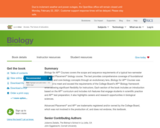
Biology for AP® Courses covers the scope and sequence requirements of a typical two-semester Advanced Placement® biology course. The text provides comprehensive coverage of foundational research and core biology concepts through an evolutionary lens. Biology for AP® Courses was designed to meet and exceed the requirements of the College Board’s AP® Biology framework while allowing significant flexibility for instructors. Each section of the book includes an introduction based on the AP® curriculum and includes rich features that engage students in scientific practice and AP® test preparation; it also highlights careers and research opportunities in biological sciences.

This lab manual and workbook was created for Majors level Biology I and II, to be used in whole or in part in any college-level course. The manual contains both labs and worksheets to be used in classes, assigned as learning activities, or used as assessments. The manual has an instructor's guide for the lab components. The manual is currently in use at Aims Community College in Colorado, USA.
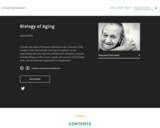
Short Description:
Includes the study of the gross and microscopic structure of the systems of the human body with special emphasis on the relationship between structure and function. Integrates anatomy and physiology of cells, tissues, organs, the systems of the human body, and mechanisms responsible for homeostasis.
Word Count: 134931
(Note: This resource's metadata has been created automatically by reformatting and/or combining the information that the author initially provided as part of a bulk import process.)

This ZOOM video segment shows how to create a self-contained environment and explores evaporation, condensation, and precipitation.

This interactive resource adapted from NASA describes the different temperature, precipitation, and vegetation patterns in seven biomes: coniferous forest, temperate deciduous forest, desert, grassland, rainforest, shrubland, and tundra.
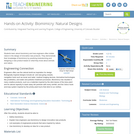
Students learn about biomimicry and how engineers often imitate nature in the design of innovative new products. They demonstrate their knowledge of biomimicry by practicing brainstorming and designing a new product based on what they know about animals and nature.
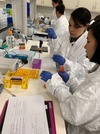
This semester, we will be implementing a group activity where we look at the histology for the leading causes of death while also exploring how these diseases disproportionately affect people of color in America. There are several components of this project that culminate in a video presentation that can be used to inform our Merritt and employer community about these diseases and how they negatively impact us. This project will be done in several steps or 7 Modules as outlined below.

What does a technology look like that will change the world? Biotechnology has the power to alter all of our lives. The ability to manipulate genes in ways that benefit people is a powerful technology. In this lesson we will explore various benefits and applications of biotechnology. You will analyze different perspectives in the race to create biotechnology. From there you will decide how you feel about “playing with genes” and how that will impact your life.StandardsBio.B.3.2.4 Students will apply scientific thinking, processes, tools, and technologies in the study of genetics.
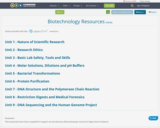
This materials have been compiled to support an introductory Biotechnology course for high school students.